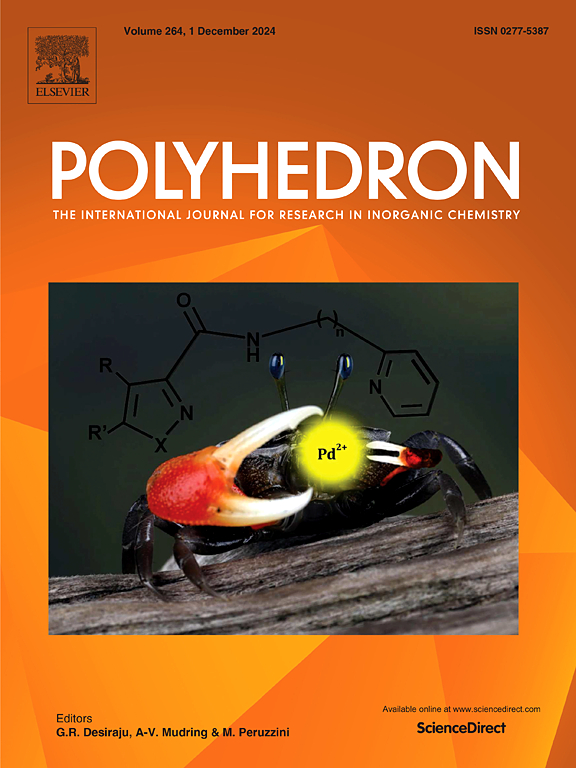Cu(I)/Fe(II)杂化配合物在C-C和C-N偶联反应中的合成、表征及催化研究
IF 2.4
3区 化学
Q2 CHEMISTRY, INORGANIC & NUCLEAR
引用次数: 0
摘要
在一种dppe的存在下,Fc-HC=NC11H11N2O与[Cu(MeCN)4]X反应,合成了一系列新的铜杂化配合物,其分子式为[Cu(Fc-HC=NC11H11N2O)(dppe)]X (1b-4b)[其中dppe = 1,2-双(二苯膦)乙烷,X = NO3−(1b), ClO4−(2b), BF4−(3b), PF6−(4b)]。研究了配合物的配位化学性质,并用元素分析、FTIR、1H NMR、31P NMR、紫外可见光谱和质谱对其结构进行了表征。热稳定性通过热重分析(TGA)评价,表面形貌通过扫描电镜(SEM)研究,代表性配合物2b的晶体结构通过x射线粉末衍射澄清。电化学研究表明,Cu(I)/Cu(II)和Fe(II)/Fe(III)偶对具有准可逆的氧化还原行为,并受螯合膦配体的影响。sonogashura型C-C和buchwald型C-N偶联反应的催化活性测试表明,所有配合物都是C-C和C-N偶联反应的有效催化剂。此外,反离子和螯合膦配体对偶联产物的产率起关键作用。本文章由计算机程序翻译,如有差异,请以英文原文为准。

Synthesis, characterization and catalytic study of heterobimetallic Cu(I)/Fe(II) hybrid complexes for C–C and C–N coupling reactions
A new series of hybrid copper complexes with the formula [Cu(Fc-HC=NC11H11N2O)(dppe)]X (1b-4b) [where dppe = 1,2-bis(diphenylphosphino)ethane and X = NO3− (1b), ClO4− (2b), BF4− (3b), PF6− (4b)] was synthesized by reacting Fc-HC=NC11H11N2O with [Cu(MeCN)4]X in the presence of one equivalent of dppe. The coordination chemistry of these complexes was investigated, and their structures were characterized using elemental analysis, FTIR, 1H NMR, 31P NMR, UV–visible spectroscopy, and mass spectrometry. Thermal stability was evaluated through thermogravimetric analysis (TGA), surface morphology study by using SEM and the crystal structure of the representative complex 2b was clarified using X-ray powder diffraction. Electrochemical studies revealed quasireversible redox behaviour associated with Cu(I)/Cu(II) and Fe(II)/Fe(III) couples, which was influenced by the chelating phosphine ligand. Catalytic activity tests for Sonogashira-type C–C and Buchwald-type C–N coupling reactions showed that all complexes worked as efficient catalyst for C–C and C–N coupling reactions. Additionally, the counter ions and chelating phosphine ligand played a critical role in determining the yield of the coupling products.
求助全文
通过发布文献求助,成功后即可免费获取论文全文。
去求助
来源期刊

Polyhedron
化学-晶体学
CiteScore
4.90
自引率
7.70%
发文量
515
审稿时长
2 months
期刊介绍:
Polyhedron publishes original, fundamental, experimental and theoretical work of the highest quality in all the major areas of inorganic chemistry. This includes synthetic chemistry, coordination chemistry, organometallic chemistry, bioinorganic chemistry, and solid-state and materials chemistry.
Papers should be significant pieces of work, and all new compounds must be appropriately characterized. The inclusion of single-crystal X-ray structural data is strongly encouraged, but papers reporting only the X-ray structure determination of a single compound will usually not be considered. Papers on solid-state or materials chemistry will be expected to have a significant molecular chemistry component (such as the synthesis and characterization of the molecular precursors and/or a systematic study of the use of different precursors or reaction conditions) or demonstrate a cutting-edge application (for example inorganic materials for energy applications). Papers dealing only with stability constants are not considered.
 求助内容:
求助内容: 应助结果提醒方式:
应助结果提醒方式:


